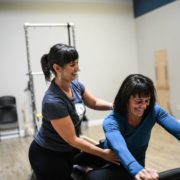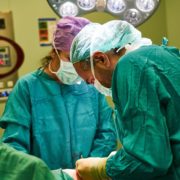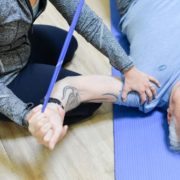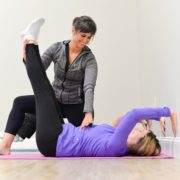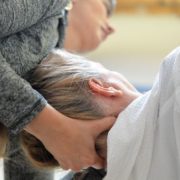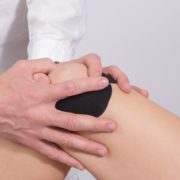The most popular goals for the New Year continue to revolve around weight loss and exercise. But here is one thing that can get in your way when pursuing those goals… unresolved back or knee pain. So many people make the mistake of thinking that exercise or weight loss alone, is going to “cure” their nagging pain. But that’s not always the case.
Here are some top tips and advice I give all my clients around this time of year to help you get the most out of your health and fitness goals for 2021, and NOT let something like back or knee pain get in your way…
Mobility before Stability
Your muscles can’t function at their best if you don’t have optimal joint mobility. In other words, you don’t want to strengthen around a joint that isn’t moving at its best, or you’ll encourage compensation. If your nagging back or knee pain is due to inadequate mobility, you’ll run into problems (and more pain) if you suddenly increase your exercise or activity level. We saw this happen at the beginning of the pandemic. People started walking and exercising more and we saw a huge influx of unexpected back and knee pain as a result. Their joints weren’t accustomed to moving so much and it highlighted the lack of mobility and compensations. Don’t let the same thing happen to you! Make sure all of your joints, including your spine, can move fully and freely without any pain before you begin a new exercise program.
Pace yourself
Siti Scommesse Basket Online: Le Migliori Opzioni di Scommezoid per il Basket
Il basket è uno sport appassionante che attira milioni di fan in tutto il mondo. Con la sua azione frenetica, le giocate spettacolari e le emozioni travolgenti, non c’è da stupirsi che sempre più persone vogliano scommettere sul basket online. Tuttavia, con l’enorme quantità di siti di scommesse disponibili, può essere difficile sapere quale scegliere. Come puoi essere sicuro di trovare un sito affidabile, sicuro e con le migliori quote?
In questo articolo, esploreremo le migliori opzioni di scommesse basket online attualmente disponibili. Analizzeremo i fattori chiave da considerare quando si sceglie un sito di scommesse, come la reputazione, la sicurezza, le quote competitive e l’esperienza utente. Inoltre, forniremo una guida dettagliata su come scommettere sul basket online in modo responsabile e divertente. Che tu sia un appassionato di lunga data o un nuovo arrivato nel mondo delle scommesse sportive, questo articolo ti darà tutte le informazioni necessarie per fare la scelta giusta e massimizzare le tue possibilità di successo.
Panoramica dei Principali Siti di Scommesse sul Basket
Il mondo delle scommesse sportive online offre un’ampia gamma di opportunità per gli appassionati di basket. Le scommesse basket online consentono di scommettere su una vasta selezione di partite, campionati e tornei, sia a livello nazionale che internazionale. Che tu sia un fan dell’NBA, dell’Euroleague o dei campionati nazionali, potrai trovare numerose opzioni per scommettere sui tuoi giocatori e squadre preferite.
Uno dei vantaggi principali delle scommesse basket online è la comodità. Puoi piazzare le tue scommesse ovunque ti trovi, direttamente dal tuo dispositivo mobile o dal tuo computer. Inoltre, i siti di scommesse online offrono spesso quote competitive e una vasta gamma di opzioni di scommessa, come le scommesse sul risultato finale, i punteggi parziali, i margini di vittoria e molto altro ancora.
Per sfruttare al meglio le scommesse basket online, è fondamentale scegliere un bookmaker affidabile e di alta qualità. Alcuni dei migliori siti di scommesse basket online offrono:
- Ampie coperture di eventi e mercati di scommessa
- Quote competitive e opzioni di scommessa diversificate
- Promozioni e bonus dedicati agli appassionati di basket
- Piattaforme user-friendly e facilmente accessibili da dispositivi mobili
Che tu sia un principiante o un giocatore esperto, le scommesse basket online rappresentano un’opportunità emozionante per aumentare il divertimento e l’emozione delle partite. Tuttavia, è importante gestire in modo responsabile il tuo bankroll e scommettere solo ciò che puoi permetterti di perdere. Con la giusta strategia e una buona dose di conoscenza del gioco, le scommesse basket online possono rivelarsi un’esperienza gratificante e coinvolgente.
Analisi delle Quote e delle Opzioni di Scommessa Offerte
Quando si tratta di scommettere sul basket online, gli appassionati di questo sport hanno una vasta gamma di opzioni a loro disposizione. I migliori siti di scommesse basket online offrono una varietà di mercati, quote competitive e funzionalità user-friendly per rendere l’esperienza di scommessa più piacevole e redditizia possibile. Alcuni dei fattori chiave da considerare nella scelta di un sito di scommesse basket includono la reputazione, la sicurezza, la varietà di mercati e le opzioni di pagamento.
Tra i siti di scommesse basket più popolari e affidabili troviamo nomi come Bet365, William Hill, Unibet e 888Sport. Questi operatori offrono una copertura completa degli eventi di basket più importanti, come l’NBA, l’Euroleague e i campionati nazionali di tutto il mondo. Inoltre, molti di questi siti offrono anche opzioni di streaming live, statistiche dettagliate e promozioni esclusive per i fan del basket, rendendo l’esperienza di scommessa ancora più coinvolgente ed emozionante.
Vantaggi e Svantaggi delle Scommesse sul Basket Online
Nel mondo delle scommesse sportive online, il basket è uno sport che sta guadagnando sempre più popolarità. Con le sue emozioni travolgenti e l’azione incessante, il basket offre numerose opportunità per i giocatori di scommettere e provare a vincere. Siti scommesse basket online come Scommezoid offrono una vasta gamma di opzioni per scommettere su questo appassionante sport.
Una delle caratteristiche principali dei migliori siti scommesse basket online è la varietà di mercati disponibili. Oltre alle scommesse tradizionali sul risultato finale, i giocatori possono scommettere su una miriade di altri aspetti del gioco, come il punteggio di un singolo quarto, il margine di vittoria, il numero di punti segnati da un giocatore specifico e molto altro ancora. Questa ampia scelta di mercati consente ai giocatori di adattare le loro strategie di scommessa alle proprie preferenze e competenze.
- Quote competitive
- Ampia copertura delle principali leghe
- Opzioni di scommessa dal vivo
- Bonus e promozioni vantaggiose
- Piattaforme user-friendly
Strategie e Consigli per Scommettere con Successo
Il basket è uno degli sport più emozionanti e seguiti al mondo, e per gli appassionati di scommesse, rappresenta un’opportunità unica per mettere alla prova le proprie abilità di previsione e strategia. Fortunatamente, esistono numerosi siti di scommesse basket online che offrono una vasta gamma di opzioni per scommettere su questo sport avvincente. Questi siti consentono di scommettere non solo sulle partite, ma anche su una miriade di altri aspetti del gioco, come il punteggio finale, il margine di vittoria, i punti realizzati dai singoli giocatori e molto altro ancora.
Quando si tratta di scegliere il miglior sito di scommesse basket online, è fondamentale considerare diversi fattori chiave. In primo luogo, è importante valutare l’affidabilità e la reputazione del sito, assicurandosi che sia regolamentato e autorizzato a operare nel proprio paese di residenza. Inoltre, è necessario prendere in considerazione l’ampiezza dell’offerta di scommesse, le quote proposte e la facilità d’uso dell’interfaccia. Alcuni dei migliori siti di scommesse basket online offrono anche interessanti bonus di benvenuto e promozioni speciali per i nuovi giocatori, rendendo l’esperienza ancora più entusiasmante.
Infine, è sempre consigliabile fare una ricerca approfondita sui diversi siti di scommesse basket online prima di effettuare la propria scelta. Leggere le recensioni degli utenti, confrontare le quote e le opzioni di scommessa offerte, e valutare attentamente i termini e le condizioni di ciascun sito può fare la differenza tra un’esperienza di scommessa positiva e una deludente. Con la giusta combinazione di conoscenza, strategia e un sito di scommesse affidabile, gli appassionati di basket possono vivere emozioni indimenticabili e, con un po’ di fortuna, anche realizzare qualche bella vincita.
Sicurezza e Affidabilità dei Siti di Scommesse sul Basket
Ecco 4 paragrafi in italiano che dettagliano “Siti Scommesse Basket Online: Le Migliori Opzioni di Scommezoid per il Basket”:
Gli appassionati di basket hanno molteplici opzioni per scommettere sui loro eventi preferiti grazie ai numerosi siti di scommesse online dedicati a questo sport. Questi siti offrono una vasta gamma di mercati di scommessa, dalle classiche quote sul risultato finale alle opzioni più dettagliate come lo spread, il totale dei punti e le scommesse sui singoli giocatori. Inoltre, molti di questi siti propongono anche streaming live degli incontri, consentendo ai giocatori di seguire l’azione in tempo reale mentre scommettono.
Uno dei principali vantaggi di scommettere sul basket online è la comodità. Non è più necessario recarsi in una sala scommesse fisica, poiché tutto può essere gestito dal proprio dispositivo mobile o computer. Inoltre, i siti di scommesse online offrono spesso quote migliori rispetto alle sale scommesse tradizionali, grazie alla riduzione dei costi operativi. Questo si traduce in potenziali vincite più elevate per i giocatori.
Quando si sceglie un sito di scommesse basket online, è importante considerare fattori come la reputazione, la sicurezza, la varietà di mercati di scommessa offerti e i bonus e le promozioni disponibili. Alcuni dei migliori siti di scommesse basket online includono:
- Bet365
- William Hill
- 888Sport
- Unibet
Questi siti sono noti per la loro affidabilità, le quote competitive e l’eccellente copertura degli eventi di basket a livello nazionale e internazionale.
Infine, è fondamentale ricordare di scommettere in modo responsabile e di gestire attentamente il proprio bankroll. Le scommesse sul basket online possono essere un’esperienza emozionante ed entusiasmante, ma è importante mantenere sempre il controllo e non lasciarsi travolgere dall’eccitazione del gioco. Con la giusta strategia e un approccio disciplinato, è possibile trarre il massimo divertimento e potenzialmente anche profitti dalle scommesse sul basket online.
In conclusione, il mondo delle scommesse sul basket online offre una vasta gamma di opzioni per gli appassionati di questo sport. Dalle migliori piattaforme come Scommezoid, che garantiscono un’esperienza di gioco sicura e affidabile, alle numerose opportunità di scommesse disponibili, gli amanti del basket possono immergersi completamente nell’emozione del gioco. Che tu sia un principiante o un esperto scommettitore, l’importante è scegliere con attenzione il sito di scommesse più adatto alle tue esigenze e goderti appieno l’adrenalina di ogni partita.
It’s very tempting to go “all in” on your new exercise or weight loss goal… but remember, the tortoise won the race, not the hare. It’s important to not beat yourself up if you’re not seeing immediate results. If you’ve been out of shape for a while and doing something completely new, expect to be sore. But if you’re limping around for days or experiencing sharp pain in your back or knee, there is a chance you overdid it.
My general rule of thumb is to monitor your soreness on a scale of one to ten. I tell my clients to not let their pain go above a five when they are pushing themselves or returning to an exercise we haven’t tried in a while. If you find that your pain level goes above a six, or persists at that level (or higher) for more than a day, there’s a chance you’re overdoing it and setting yourself up for an unwanted injury. When in doubt, listen to your body. And if you’re not sure what it’s saying to you, enlist the help of experts like us!
Stay Hydrated
Most people don’t drink enough water during their regular day, never mind when they increase their activity level. Drinking lots of water has two great benefits. It will give you the extra hydration you need if you’re planning to be more active. And it will help you lose weight by curbing your appetite. Some additional benefits of staying hydrated include increased muscle strength and stamina, more lubrication in your joints, more supple skin, better cardiovascular function, and improved energy and mental alertness. One really easy tip to jumpstart your day is to begin with 10 oz of water first thing upon waking. A good place to start when you’re trying to stay adequately hydrated is to drink at least half your body weight (in ounces) of water every day.
Get assessed by a movement expert
If you’ve already got some nagging back and knee pain, do yourself a favor and get assessed by a movement expert FIRST, before you begin your new exercise routine or New Year’s goal. Your first thought might be to go see your medical doctor, which of course isn’t a bad idea, but it’s important you understand how different medical professionals look at you when you have knee or back pain.
Medical doctors are trained to screen your whole body and spot for serious problems. If you see them for musculoskeletal pain, they will typically take X-rays and MRI’s to make sure there are no broken bones or serious pathologies. They do not have extensive training to assess how your pain behaves during movement or exercise, which is the majority of people’s problems. That’s where we come in.
A specialty practice like ours will be able to assess your movement in detail, through various movement tests, which will tell a much better story about how your pain may or may not impact the new exercise or weight loss program you’re about to start. Plus, once we know how your pain behaves, what the triggering patterns are, we can also teach you how to control it – so that you don’t have to let nagging back or knee pain derail your 2021!
I hope your New Year is off to an amazing start, and if you want to ensure that back or knee pain doesn’t get in the way of that, reach out for a FREE 30 minute Discovery Session. We would love to talk with you about your goals and be part of your support team as we all launch into 2023!

